2007 ISUZU KB P190 engine
[x] Cancel search: enginePage 1284 of 6020

6E-250 Engine Control System (4JH1)
Step Action Value(s) Yes No
7 Repair the short to ground between the pressure
switch (pin 2 of C-24 connector) and the electronic
thermostat (pin 2 of C-55 connector).
Did you complete the repair?
Go to Step 43
8 1. Test the electronic thermostat switching circuits
shorted each other. (pins 1 and 2 of C-55
connector).
2. Repair the circuits as necessary.
Did you find and correct the condition?
Go to Step 43 Go to Step 39
9 1. Test the electronic thermostat circuit between the electronic thermostat (pin 4 of C-55 connector)
and the A/C switch (pin 11 of B-57 connector) for
a short to ground.
2. Repair the circuits as necessary.
Did you find and correct the condition?
Go to Step 43 Go to Step 40
10 1. Test the ground circuit among the electronic thermostat (pin 1 of C-55 connector), the blower
motor switch (pin 1 of B-13 connector) and the
A/C switch (pin 10 of B-57 connector) for a short
to ground.
2. Repair the circuits as necessary.
Did you find and correct the condition?
Go to Step 43 Go to Step 41
11 Inspect the A/C (10A) fuse (EB-13) in the engine room fuse block.
Is the A/C (10A) fuse (EB-13) open?
Go to Step 12 Go to Step 13
12 1. Replace the A/C (10A) fuse (EB-13). If the fuse continues to open, repair the short to ground on
a circuit fed by the fuse or check for a shorted
attached component.
2. Repair the short to ground or replace the component as necessary.
Did you complete the repair?
Go to Step 43
13 1. Turn OFF the ignition.
2. Remove the thermo relay from the engine room relay block.
3. Connect a test lamp between the voltage feed circuit (pins 2 and 3 of X-15 connector) and a
known good ground.
4. Turn ON the ignition, with the engine OFF.
Does the test lamp illuminate on both circuits?
Go to Step 14 Go to Step 23
14 1. Turn OFF the ignition. 2. Reinstall the thermo relay.
3. Remove the radiator grille in order to access the pressure switch.
4. Disconnect the pressure switch harness connector (C-24).
5. Connect a 3-amp fused jumper wire between the pressure switch harness (pin 1 of C-24
connector) and a known good ground.
6. Turn ON the ignition, with the engine OFF.
Does the thermo relay click (engage)?
Go to Step 15 Go to Step 17
15 Does the A/C Clutch Switch parameter indicate ON?
Go to Step 18 Go to Step 16
BACK TO CHAPTER INDEX
TO MODEL INDEX
ISUZU KB P190 2007
Page 1285 of 6020

Engine Control System (4JH1) 6E-251
Step Action Value(s) Yes No
16 1. Turn OFF the ignition.
2. Keep the 3-amp fused wire with connected.
3. Disconnect the ECM C-56 harness connector.
4. Connect a test lamp between the thermo relay input circuit (pin 33 of C-56 connector) and a
known good ground.
5. Turn ON the ignition, with the engine OFF. DO NOT START the engine.
Does the test lamp illuminate?
Go to Step 36 Go to Step 24
17 1. Turn OFF the ignition. 2. Keep the 3-amp fused wire with connected.
3. Replace the thermo relay with the horn relay or replace with a known good relay.
4. Connect a 3-amp fused jumper wire between the pressure switch harness (pin 1 of C-24
connector) and a known good ground.
5. Turn ON the ignition, with the engine OFF.
Does the thermo relay click (engage)?
Go to Step 31 Go to Step 25
18 1. Turn OFF the ignition. 2. Connect the pressure switch harness connector.
3. Remove the grove box in order to access electronic thermostat.
4. Disconnect the electronic thermostat harness connector (C-55).
5. Connect a 3-amp fused jumper wire between the electronic thermostat voltage feed circuit (pin 2 of
C-55 connector) and a known good ground.
6. Turn ON the ignition, with the engine OFF.
Does the thermo relay click (engage)?
Go to Step 19 Go to Step 26
19 1. Turn OFF the ignition. 2. Connect a test lamp between the electronic thermostat terminal (pin 1 of C-55 connector) and
battery voltage.
3. Turn ON the blower motor switch.
Does the test lamp illuminate?
Go to Step 20 Go to Step 27
20 1. Turn OFF the ignition. 2. Connect a test lamp between the electronic thermostat voltage feed circuit (pin 3 of C-55
connector) and a known good ground.
3. Turn ON the ignition, with the engine OFF.
Does the test lamp illuminate?
Go to Step 21 Go to Step 28
21 1. Turn OFF the ignition. 2. Connect a test lamp between the electronic thermostat terminal (pin 4 of C-55 connector) and
battery voltage.
3. Turn ON the blower motor switch.
4. Turn ON the A/C switch.
Does the test lamp illuminate?
Go to Step 33 Go to Step 22
BACK TO CHAPTER INDEX
TO MODEL INDEX
ISUZU KB P190 2007
Page 1286 of 6020
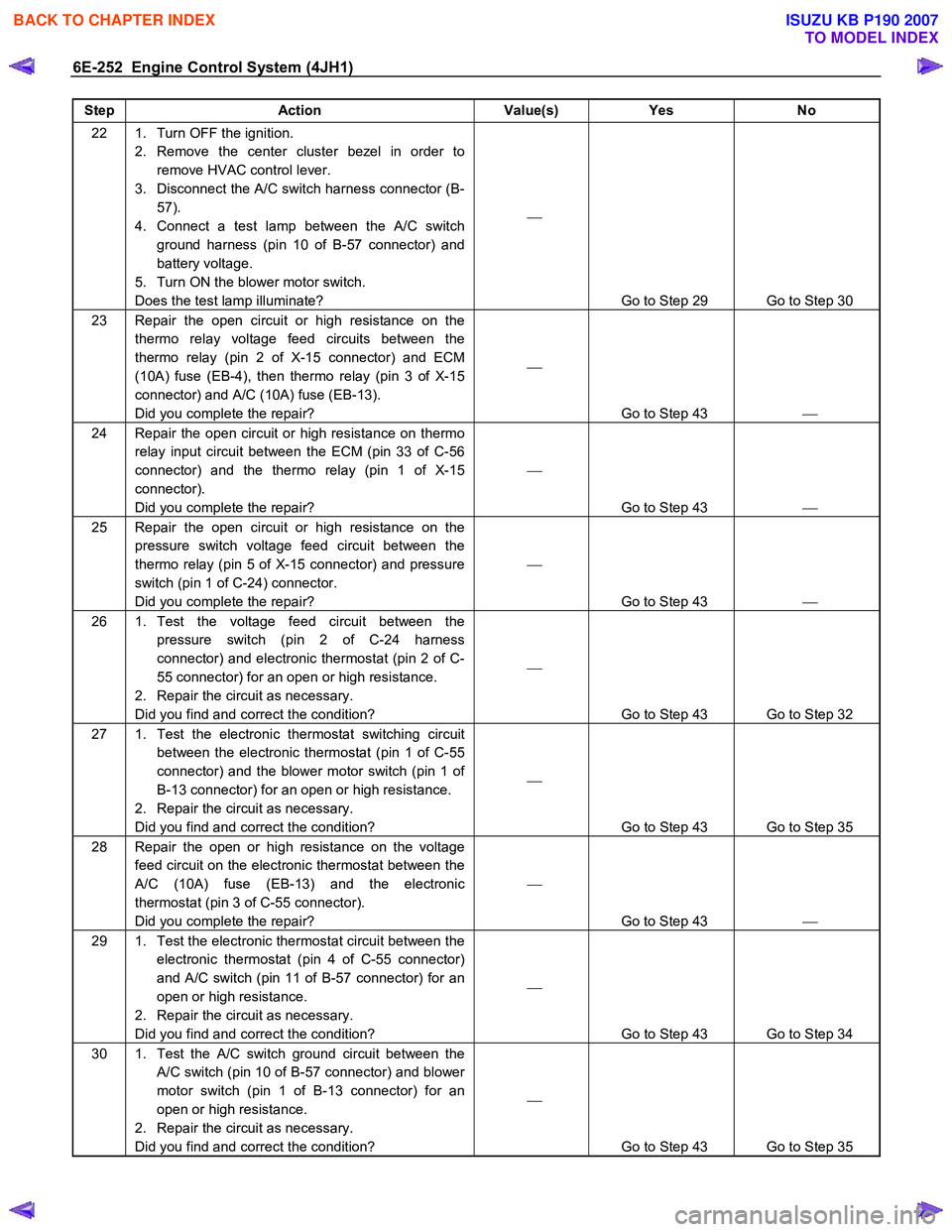
6E-252 Engine Control System (4JH1)
Step Action Value(s) Yes No
22 1. Turn OFF the ignition.
2. Remove the center cluster bezel in order to remove HVAC control lever.
3. Disconnect the A/C switch harness connector (B- 57).
4. Connect a test lamp between the A/C switch ground harness (pin 10 of B-57 connector) and
battery voltage.
5. Turn ON the blower motor switch.
Does the test lamp illuminate?
Go to Step 29 Go to Step 30
23 Repair the open circuit or high resistance on the thermo relay voltage feed circuits between the
thermo relay (pin 2 of X-15 connector) and ECM
(10A) fuse (EB-4), then thermo relay (pin 3 of X-15
connector) and A/C (10A) fuse (EB-13).
Did you complete the repair?
Go to Step 43
24 Repair the open circuit or high resistance on thermo
relay input circuit between the ECM (pin 33 of C-56
connector) and the thermo relay (pin 1 of X-15
connector).
Did you complete the repair?
Go to Step 43
25 Repair the open circuit or high resistance on the
pressure switch voltage feed circuit between the
thermo relay (pin 5 of X-15 connector) and pressure
switch (pin 1 of C-24) connector.
Did you complete the repair?
Go to Step 43
26 1. Test the voltage feed circuit between the
pressure switch (pin 2 of C-24 harness
connector) and electronic thermostat (pin 2 of C-
55 connector) for an open or high resistance.
2. Repair the circuit as necessary.
Did you find and correct the condition?
Go to Step 43 Go to Step 32
27 1. Test the electronic thermostat switching circuit between the electronic thermostat (pin 1 of C-55
connector) and the blower motor switch (pin 1 of
B-13 connector) for an open or high resistance.
2. Repair the circuit as necessary.
Did you find and correct the condition?
Go to Step 43 Go to Step 35
28 Repair the open or high resistance on the voltage feed circuit on the electronic thermostat between the
A/C (10A) fuse (EB-13) and the electronic
thermostat (pin 3 of C-55 connector).
Did you complete the repair?
Go to Step 43
29 1. Test the electronic thermostat circuit between the
electronic thermostat (pin 4 of C-55 connector)
and A/C switch (pin 11 of B-57 connector) for an
open or high resistance.
2. Repair the circuit as necessary.
Did you find and correct the condition?
Go to Step 43 Go to Step 34
30 1. Test the A/C switch ground circuit between the A/C switch (pin 10 of B-57 connector) and blower
motor switch (pin 1 of B-13 connector) for an
open or high resistance.
2. Repair the circuit as necessary.
Did you find and correct the condition?
Go to Step 43 Go to Step 35
BACK TO CHAPTER INDEX
TO MODEL INDEX
ISUZU KB P190 2007
Page 1287 of 6020
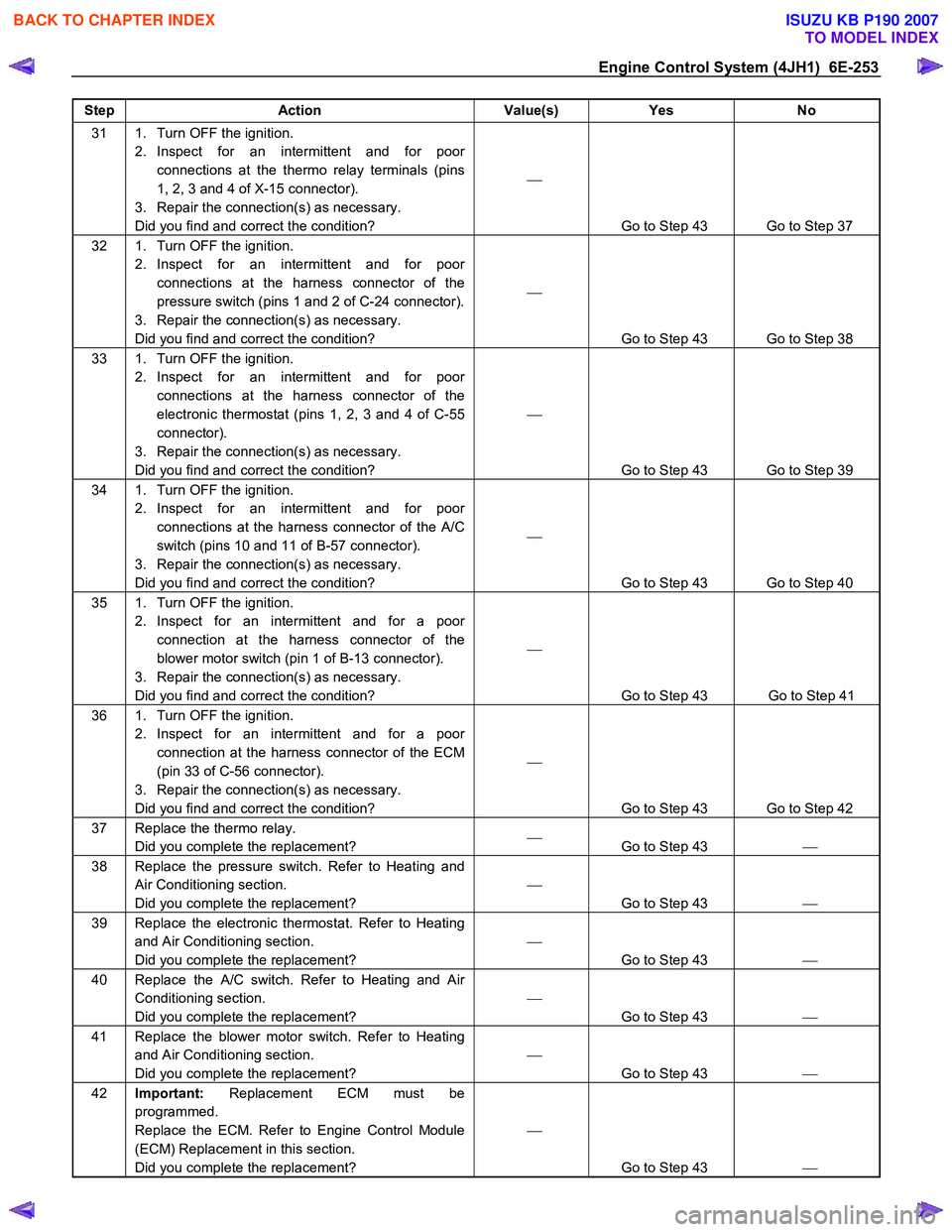
Engine Control System (4JH1) 6E-253
Step Action Value(s) Yes No
31 1. Turn OFF the ignition.
2. Inspect for an intermittent and for poor connections at the thermo relay terminals (pins
1, 2, 3 and 4 of X-15 connector).
3. Repair the connection(s) as necessary.
Did you find and correct the condition?
Go to Step 43 Go to Step 37
32 1. Turn OFF the ignition. 2. Inspect for an intermittent and for poor connections at the harness connector of the
pressure switch (pins 1 and 2 of C-24 connector).
3. Repair the connection(s) as necessary.
Did you find and correct the condition?
Go to Step 43 Go to Step 38
33 1. Turn OFF the ignition. 2. Inspect for an intermittent and for poor connections at the harness connector of the
electronic thermostat (pins 1, 2, 3 and 4 of C-55
connector).
3. Repair the connection(s) as necessary.
Did you find and correct the condition?
Go to Step 43 Go to Step 39
34 1. Turn OFF the ignition. 2. Inspect for an intermittent and for poor connections at the harness connector of the A/C
switch (pins 10 and 11 of B-57 connector).
3. Repair the connection(s) as necessary.
Did you find and correct the condition?
Go to Step 43 Go to Step 40
35 1. Turn OFF the ignition. 2. Inspect for an intermittent and for a poor connection at the harness connector of the
blower motor switch (pin 1 of B-13 connector).
3. Repair the connection(s) as necessary.
Did you find and correct the condition?
Go to Step 43 Go to Step 41
36 1. Turn OFF the ignition. 2. Inspect for an intermittent and for a poor connection at the harness connector of the ECM
(pin 33 of C-56 connector).
3. Repair the connection(s) as necessary.
Did you find and correct the condition?
Go to Step 43 Go to Step 42
37 Replace the thermo relay. Did you complete the replacement?
Go to Step 43
38 Replace the pressure switch. Refer to Heating and
Air Conditioning section.
Did you complete the replacement?
Go to Step 43
39 Replace the electronic thermostat. Refer to Heating
and Air Conditioning section.
Did you complete the replacement?
Go to Step 43
40 Replace the A/C switch. Refer to Heating and Air
Conditioning section.
Did you complete the replacement?
Go to Step 43
41 Replace the blower motor switch. Refer to Heating
and Air Conditioning section.
Did you complete the replacement?
Go to Step 43
42 Important: Replacement ECM must be
programmed.
Replace the ECM. Refer to Engine Control Module
(ECM) Replacement in this section.
Did you complete the replacement?
Go to Step 43
BACK TO CHAPTER INDEX
TO MODEL INDEX
ISUZU KB P190 2007
Page 1288 of 6020
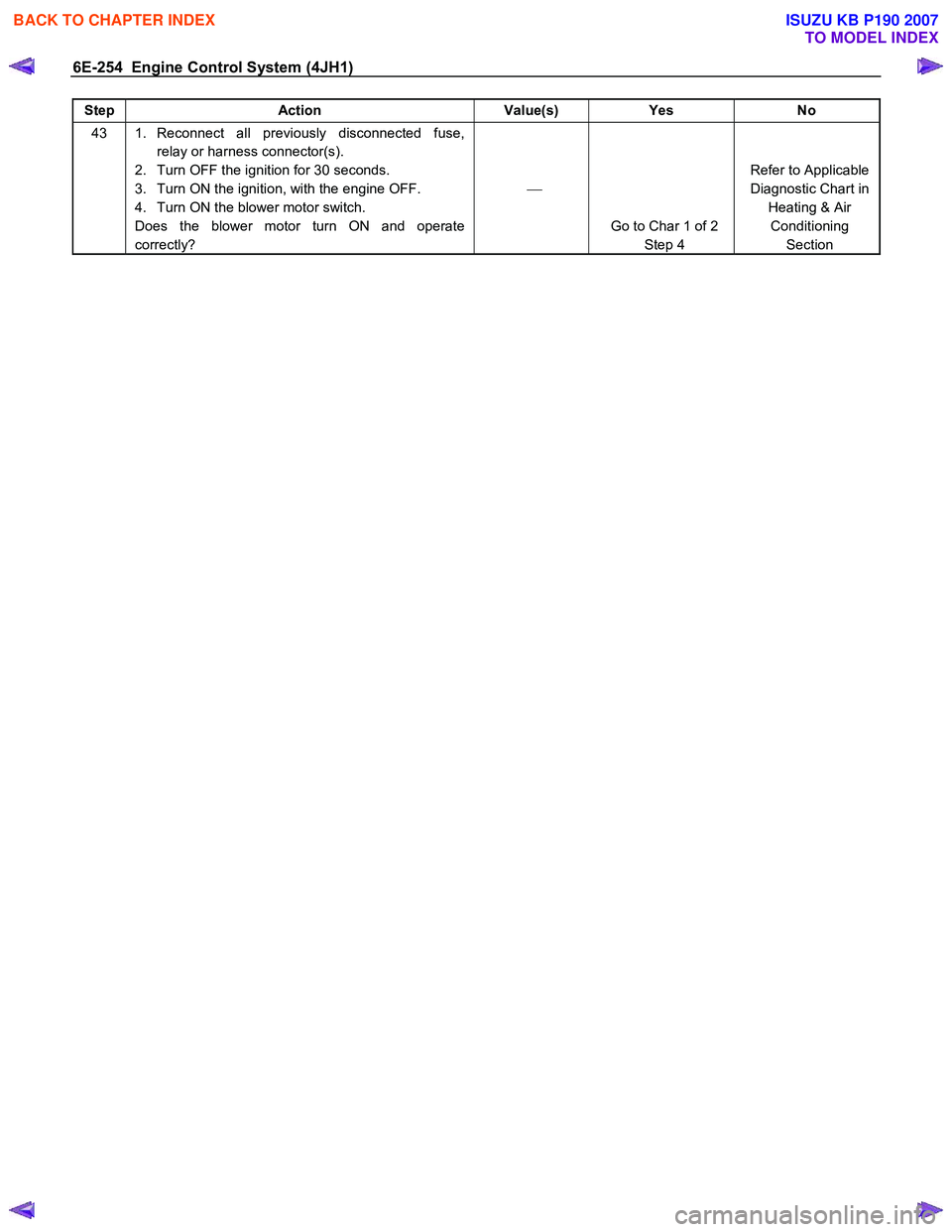
6E-254 Engine Control System (4JH1)
Step Action Value(s) Yes No
43 1. Reconnect all previously disconnected fuse,
relay or harness connector(s).
2. Turn OFF the ignition for 30 seconds.
3. Turn ON the ignition, with the engine OFF.
4. Turn ON the blower motor switch.
Does the blower motor turn ON and operate
correctly?
Go to Char 1 of 2 Step 4 Refer to Applicable
Diagnostic Chart in Heating & Air Conditioning Section
BACK TO CHAPTER INDEX
TO MODEL INDEX
ISUZU KB P190 2007
Page 1289 of 6020
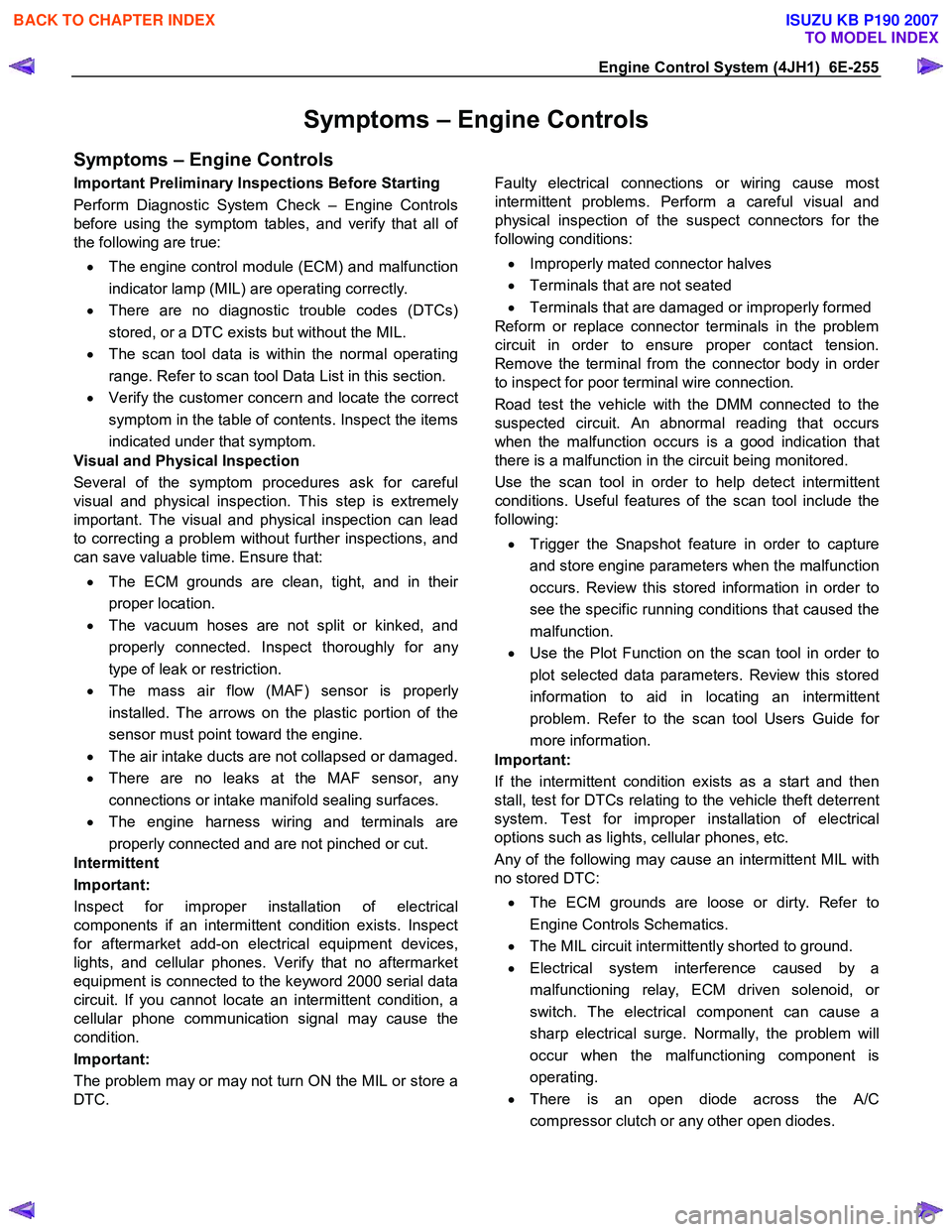
Engine Control System (4JH1) 6E-255
Symptoms – Engine Controls
Symptoms – Engine Controls
Important Preliminary Inspections Before Starting
Perform Diagnostic System Check – Engine Controls
before using the symptom tables, and verify that all o
f
the following are true:
• The engine control module (ECM) and malfunction
indicator lamp (MIL) are operating correctly.
• There are no diagnostic trouble codes (DTCs)
stored, or a DTC exists but without the MIL.
• The scan tool data is within the normal operating
range. Refer to scan tool Data List in this section.
• Verify the customer concern and locate the correct
symptom in the table of contents. Inspect the items
indicated under that symptom.
Visual and Physical Inspection
Several of the symptom procedures ask for careful
visual and physical inspection. This step is extremel
y
important. The visual and physical inspection can lead
to correcting a problem without further inspections, and
can save valuable time. Ensure that:
• The ECM grounds are clean, tight, and in thei
r
proper location.
• The vacuum hoses are not split or kinked, and
properly connected. Inspect thoroughly for an
y
type of leak or restriction.
• The mass air flow (MAF) sensor is properl
y
installed. The arrows on the plastic portion of the
sensor must point toward the engine.
• The air intake ducts are not collapsed or damaged.
• There are no leaks at the MAF sensor, an
y
connections or intake manifold sealing surfaces.
• The engine harness wiring and terminals are
properly connected and are not pinched or cut.
Intermittent
Important:
Inspect for improper installation of electrical
components if an intermittent condition exists. Inspect
for aftermarket add-on electrical equipment devices,
lights, and cellular phones. Verify that no aftermarket
equipment is connected to the keyword 2000 serial data
circuit. If you cannot locate an intermittent condition, a
cellular phone communication signal may cause the
condition.
Important:
The problem may or may not turn ON the MIL or store a
DTC.
Faulty electrical connections or wiring cause most
intermittent problems. Perform a careful visual and
physical inspection of the suspect connectors for the
following conditions:
• Improperly mated connector halves
• Terminals that are not seated
• Terminals that are damaged or improperly formed
Reform or replace connector terminals in the problem
circuit in order to ensure proper contact tension.
Remove the terminal from the connector body in orde
r
to inspect for poor terminal wire connection.
Road test the vehicle with the DMM connected to the
suspected circuit. An abnormal reading that occurs
when the malfunction occurs is a good indication that
there is a malfunction in the circuit being monitored.
Use the scan tool in order to help detect intermittent
conditions. Useful features of the scan tool include the
following:
• Trigger the Snapshot feature in order to capture
and store engine parameters when the malfunction
occurs. Review this stored information in order to
see the specific running conditions that caused the
malfunction.
• Use the Plot Function on the scan tool in order to
plot selected data parameters. Review this stored
information to aid in locating an intermittent
problem. Refer to the scan tool Users Guide fo
r
more information.
Important:
If the intermittent condition exists as a start and then
stall, test for DTCs relating to the vehicle theft deterrent
system. Test for improper installation of electrical
options such as lights, cellular phones, etc.
Any of the following may cause an intermittent MIL with
no stored DTC:
• The ECM grounds are loose or dirty. Refer to
Engine Controls Schematics.
• The MIL circuit intermittently shorted to ground.
• Electrical system interference caused by a
malfunctioning relay, ECM driven solenoid, o
r
switch. The electrical component can cause a
sharp electrical surge. Normally, the problem will
occur when the malfunctioning component is
operating.
• There is an open diode across the A/C
compressor clutch or any other open diodes.
BACK TO CHAPTER INDEX
TO MODEL INDEX
ISUZU KB P190 2007
Page 1290 of 6020
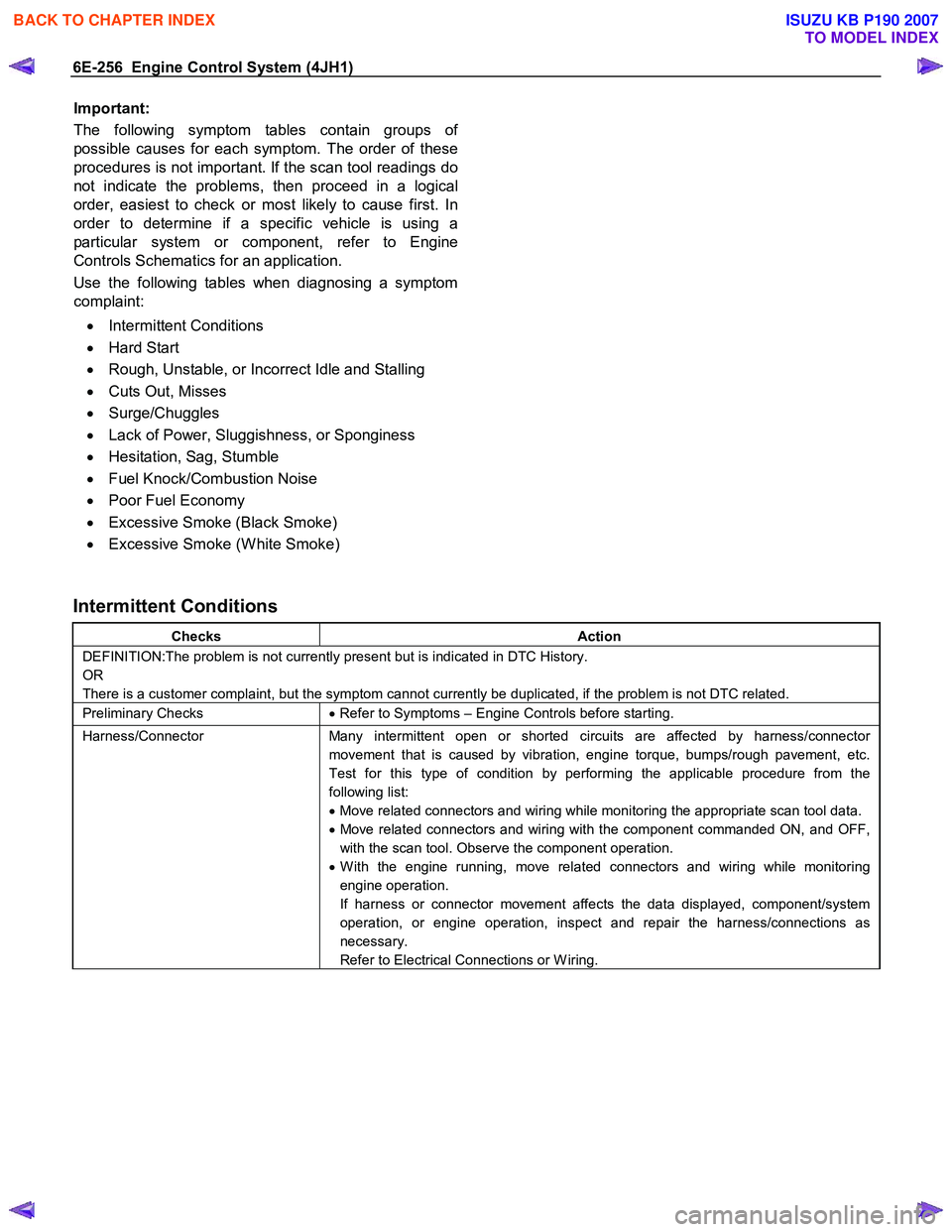
6E-256 Engine Control System (4JH1)
Important:
The following symptom tables contain groups o
f
possible causes for each symptom. The order of these
procedures is not important. If the scan tool readings do
not indicate the problems, then proceed in a logical
order, easiest to check or most likely to cause first. In
order to determine if a specific vehicle is using a
particular system or component, refer to Engine
Controls Schematics for an application.
Use the following tables when diagnosing a symptom
complaint:
• Intermittent Conditions
• Hard Start
• Rough, Unstable, or Incorrect Idle and Stalling
• Cuts Out, Misses
• Surge/Chuggles
• Lack of Power, Sluggishness, or Sponginess
• Hesitation, Sag, Stumble
• Fuel Knock/Combustion Noise
• Poor Fuel Economy
• Excessive Smoke (Black Smoke)
• Excessive Smoke (W hite Smoke)
Intermittent Conditions
Checks Action
DEFINITION:The problem is not currently present but is indicated in DTC History.
OR
There is a customer complaint, but the symptom cannot currently be duplicated, if the problem is not DTC related.
Preliminary Checks • Refer to Symptoms – Engine Controls before starting.
Harness/Connector Many intermittent open or shorted circuits are affected by harness/connector
movement that is caused by vibration, engine torque, bumps/rough pavement, etc.
Test for this type of condition by performing the applicable procedure from the
following list:
• Move related connectors and wiring while monitoring the appropriate scan tool data.
• Move related connectors and wiring with the component commanded ON, and OFF,
with the scan tool. Observe the component operation.
• W ith the engine running, move related connectors and wiring while monitoring
engine operation.
If harness or connector movement affects the data displayed, component/system
operation, or engine operation, inspect and repair the harness/connections as
necessary.
Refer to Electrical Connections or W iring.
BACK TO CHAPTER INDEX
TO MODEL INDEX
ISUZU KB P190 2007
Page 1291 of 6020

Engine Control System (4JH1) 6E-257
Checks Action
Electrical Connections or W iring Poor electrical connections, terminal tension or wiring problems cause most intermittent. To perform the following inspections:
• Inspect for poor mating of the connector halves, or terminals improperly seated in the
connector body.
• Inspect for improperly formed or damaged terminals. Test for poor terminal tension.
• Inspect for poor terminal to wire connections including terminals crimped over
insulation. This requires removing the terminal from the connector body.
• Inspect for corrosion/water intrusion. Pierced or damaged insulation can allow
moisture to enter the wiring. The conductor can corrode inside the insulation, with
little visible evidence. Look for swollen and stiff sections of wire in the suspect
circuits.
• Inspect for wires that are broken inside the insulation.
• Inspect the harness for pinched, cut or rubbed through wiring.
• Ensure that the wiring does not come in contact with hot exhaust components.
Control Module Power and Grounds
Component Power and Grounds Poor power or ground connections can cause widely varying symptoms.
• Test all control module power supply circuits. Many vehicles have multiple circuits
supplying power to the control module. Other components in the system may have
separate power supply circuits that may also need to be tested. Inspect connections
at the module/component connectors, fuses, and any intermediate connections
between the power source and the module/component. A test lamp or a DMM may
indicate that voltage is present, but neither tests the ability of the circuit to carry
sufficient current. Ensure that the circuit can carry the current necessary to operate
the component.
• Test all control module ground and system ground circuits. The control module may
have multiple ground circuits. Other components in the system may have separate
grounds that may also need to be tested. Inspect grounds for clean and tight
connections at the grounding point. Inspect the connections at the component and in
splice packs, where applicable. Ensure that the circuit can carry the current
necessary to operate the component.
Temperature Sensitivity • An intermittent condition may occur when a component/connection reaches normal
operating temperature. The condition may occur only when the
component/connection is cold, or only when the component/connection is hot.
• If the intermittent is related to heat, review the data for a relationship with the
following: - High ambient temperatures
- Under hood/engine generated heat
- Circuit generated heat due to a poor connection, or high electrical load
- Higher than normal load conditions, towing, etc.
• If the intermittent is related to cold, review the data for the following:
- Low ambient temperatures–In extremely low temperatures, ice may form in a connection or component. Test for water intrusion.
- The condition only occurs on a cold start.
- The condition goes away when the vehicle warms up.
• Information from the customer may help to determine if the trouble follows a pattern
that is temperature related.
BACK TO CHAPTER INDEX
TO MODEL INDEX
ISUZU KB P190 2007